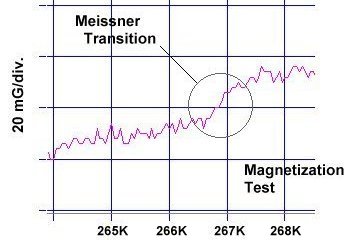
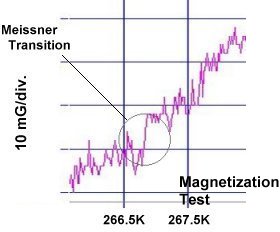


Superconductors.ORG herein reports signs of superconductivity near 267K magnetic and 265K resistive (-8C, 17F) in the compound (Tl4Ba)Ba2MgCu8O13+. This would be the third world record for a 9223 copper-oxide structure.
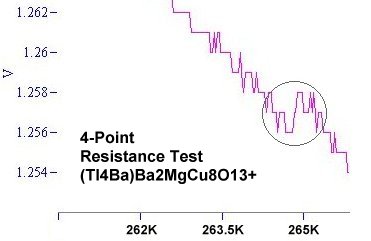
After the recent discovery of superconductivity near 258 Kelvin, an effort was made to identify a small anomaly a few degrees above 260K in the magnetization plots of (Tl4Ba)-9223-Mg2 (see plot below right). It was thought this might be a minority phase with the same elemental composition but with different structure type. Since magnesium and copper have nearly identical ionic radii, an assumption was made that the Mg and Cu atoms were exchanging positions in the CuO2 layers: C1 axis to C2 and C2 to C1 (see graphic below left). If indeed Mg and Cu were trading places, this could be confirmed by synthesizing a sample with this new stoichiometry (MgCu2). This should produce a larger volume fraction and, therefore, a stronger signal when tested.
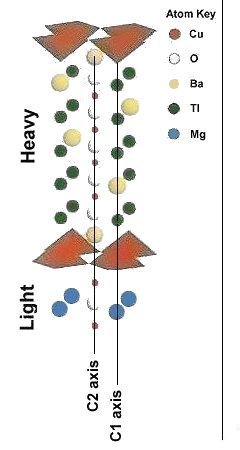
|
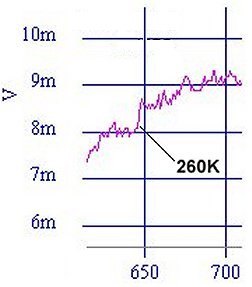 A stoichiometric mix with one less Mg and one more Cu atom was produced using the "layer cake" method (shown below). The resulting formulation (Tl4Ba)Ba2MgCu8O13+ revealed diamagnetic transitions near 267K in five separate magnetization tests and resistive transitions near 265K (see examples at page top). |
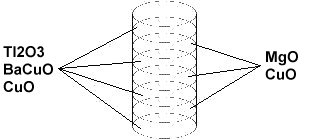
Moving Mg into the dominant C1 axis increases its planar weight ratio from 5.0 to 6.3. And since greater planar weight disparity (PWD) translates into higher Tc, one would expect an increase in Tc. The resulting location of (Tl4Ba)-9223-Mg in the plot below agrees favorably with the tendency of the curves to roll over and flatten as we approach room temperature.
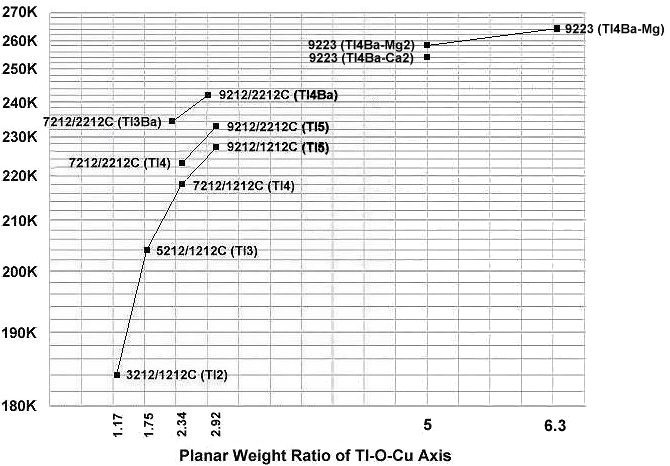
As with prior discoveries that are asymmetrical along the C axis, the volume fraction of the 265K material is low (<1%). Even so, it's believed this is the one investors will watch. In fact, this could be a game-changer. Room-temperature superconductivity is not necessary to start a technological revolution. You just have to get superconductors to work at temperatures found in the average home. Household freezer technology is now more than adequate to support practical superconductivity. Once a refinement method is developed to purify this material, superconductors will move rapidly from an industrial novelty into our everyday lives.
As a result of a low VF, numerous R-T and magnetization tests may be necessary to see the respective transitions above the noise. This discovery is being released into the public domain without patent protection in order to encourage additional research. Synthesis was by the solid state reaction method.
The below stoichiometric ratios were used for the ODD layers:
Tl2O3 99.99% (Alfa Aesar) 7.61 grains...and the below stoichiometric ratios for the EVEN layers.
MgO 99.95% (Alfa Aesar) 0.34 grainsThe chemical precursors were pelletized at 70,000 PSI and sintered for 35-36 hours at 865C. The pellet was then annealed for 10 hours at 500C in flowing O2. The magnetometer employed twin Honeywell SS94A1F Hall-effect sensors with a tandem sensitivity of 50 mv/gauss. The 4-point probe was bonded to the pellet with CW2400 silver epoxy and used 7 volts on the primary.
RESEARCH NOTE: The copper-oxides are strongly hygroscopic. All tests should be performed immediately after annealing.
E. Joe Eck
© 2010 Superconductors.ORG
All rights reserved.
 BACK to "News" page at Superconductors.ORG
BACK to "News" page at Superconductors.ORG